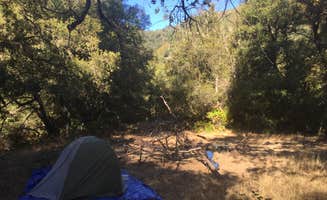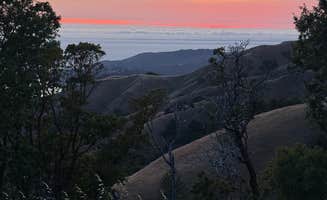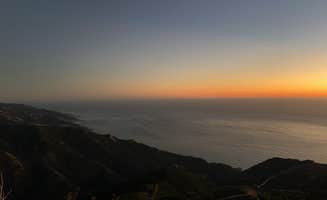Dispersed camping opportunities near Seaside, California extend across the Los Padres National Forest and Ventana Wilderness area. Primitive camping sites range from 1,000 feet to over 5,800 feet in elevation. Trail camps in this region experience a Mediterranean climate with dry summers and mild, wet winters, creating seasonal challenges for backcountry campers. Most sites require specific navigation tools and wilderness preparedness due to unmarked trails and limited signage.
What to do
Day hiking from base camps: Primitive camps like Timber Top Camp serve as excellent starting points for day explorations. "Even if you can make it to the top, there are spots to camp all along the trail," notes camper Carina M., highlighting the flexibility for hikers of different abilities.
River exploration: Multiple stream crossings characterize many trails in the region. At Bluff Camp, backcountry camping provides direct access to the Carmel River watershed. One camper explains, "The trail is pretty easy to follow, but crosses the river/creek extremely frequently," making water shoes and quick-dry clothing essential equipment.
Wildlife observation: The remote nature of these dispersed camping areas provides opportunities to spot local wildlife including deer, coyotes, and numerous bird species. Morning and evening hours offer the best viewing chances, particularly near water sources where animals gather.
What campers like
Solitude and privacy: Backcountry camping near Seaside offers exceptional isolation compared to developed campgrounds. Cone Peak provides a true wilderness experience with limited encounters with other hikers. One visitor described it as "one of the most beautiful backpacking hikes I've ever done," highlighting the solitary nature of the experience.
Mountain-to-sea views: The unique geography offers rare vantage points where ocean panoramas meet mountain landscapes. Campers report exceptional viewsheds, particularly at sunset. "The sunset was one of the best I have ever seen," reports a Cone Peak visitor, referring to the distinctive coastal-mountain view combination.
Ecological diversity: The transition zones between coastal and mountain environments create habitat for diverse plant communities. Trails pass through oak woodlands, chaparral, and at higher elevations, coniferous forests, offering botanical interest for nature enthusiasts.
What you should know
Water availability challenges: Water sources are inconsistent throughout the region, particularly at higher elevations. A Nacimiento Road Camp visitor noted carrying all water needs due to unreliable seasonal springs. One camper at Cone Peak reported: "Limited water on trail. Saw some springs during the first half but none within miles of the top."
Property boundary awareness: Recent reports indicate some areas advertised as public camping may be on private property. One visitor to Bluff Camp stated: "Private property, you can't even go through the road," highlighting the importance of verifying land status before planning trips.
Wind exposure: Higher elevation sites experience significant wind, particularly in afternoons and evenings. Tent stake reinforcement and strategic site selection are recommended. At ridge and summit locations, natural windbreaks are minimal or nonexistent.
Trail maintenance issues: Many trails receive limited maintenance, resulting in seasonal overgrowth, fallen trees, and erosion challenges. Backcountry routes may become obscured, requiring navigation skills and recent trail condition reports.
Tips for camping with families
Choose accessible base camps: When camping with children near Seaside, select lower-elevation sites with more reliable access. Multiple primitive camping options exist within 3 miles of trailheads, reducing hiking difficulty for younger campers.
Wildlife safety protocols: Establish clear food storage and wildlife awareness guidelines for children. All food should be properly stored in approved containers to prevent wildlife encounters, particularly in bear country.
Emergency communications: Cell service is extremely limited throughout the region. For family safety, consider carrying satellite communication devices when venturing into Timber Top Camp and other remote areas. "It's a ~2.8 mile hike in, but it is worth every step," notes one camper, indicating the isolation that requires communication preparation.
Weather preparedness: Coastal influence creates unpredictable conditions including fog, sudden temperature drops, and precipitation. Pack additional layers and rain gear for children even during summer months.
Tips from RVers
Access road limitations: Roads accessing primitive camping areas near Seaside frequently present challenges for larger vehicles. Most dispersed camping options require high-clearance vehicles or hiking from parking areas suitable for standard vehicles.
Overnight parking alternatives: For RVers unable to access primitive sites, several developed campgrounds within 20 miles offer basic facilities. These provide alternatives when backcountry camping is impractical due to vehicle constraints or supply needs.
Supply logistics: With limited facilities at primitive camping sites, RVers report creating supply caches at vehicle-accessible points before hiking into remote camps. This strategy allows for longer backcountry stays without carrying all supplies initially.




